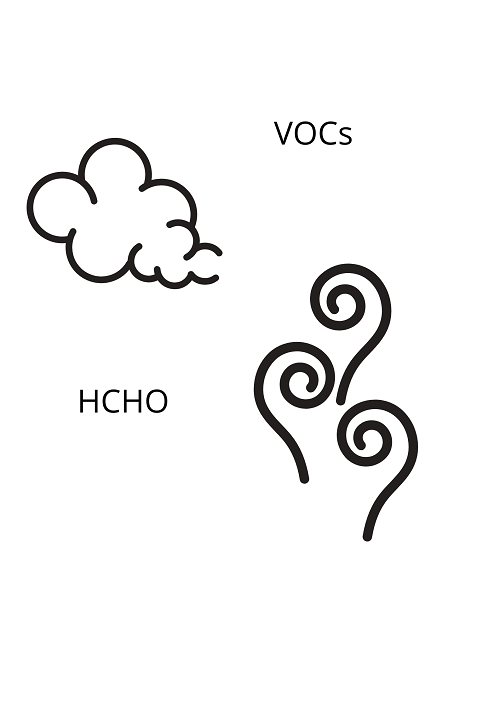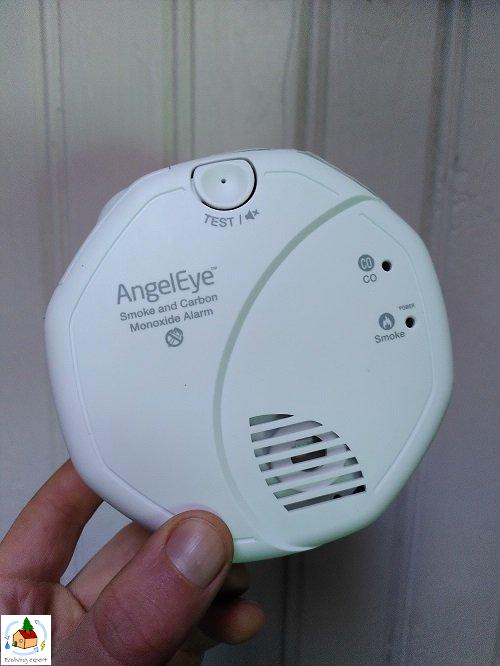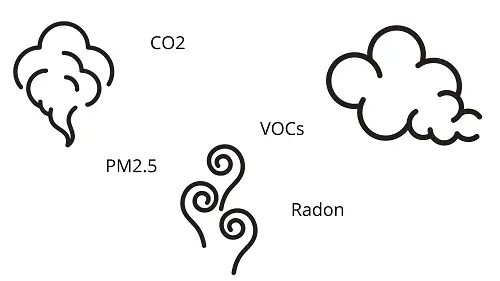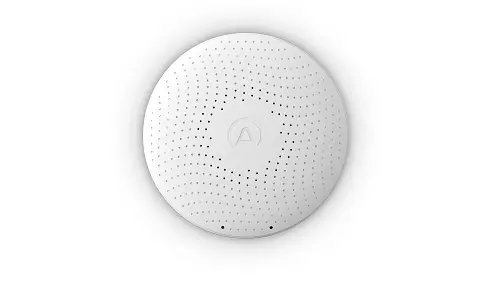
Air quality monitors measure a variety of conditions and compounds that are common in households and are potentially harmful to human health. These compounds and conditions include:
- Particulate matter (PM2.5 – PM1)
- volatile organic compounds (VOCs)
- formaldehyde (HCHO)
- carbon monoxide (CO)
- carbon dioxide (CO2)
- radon gas
- temperature
- humidity
- air pressure
The air contains all kinds of naturally occurring gases and particles. On top of that, human-made compounds are present everywhere. Potentially harmful human-made compounds are for example car exhausts or the compounds that cause the smell from drying paint or glue. In nature, they occur in very low amounts while in cities and especially indoors, some compounds can reach concentrations that are harmful to our health.
As I learned in toxicology class, not necessarily the compound itself, but the concentration (the amount) of it determines whether it is harmful or not. An air quality monitor helps detect the presence of unwanted compounds in our air and indicates if action needs to be taken.
For example, CO2 is a naturally occurring gas that humans breathe out and plants take in. Harmless natural concentrations are around 0.04% of the air. However, due to lack of ventilation, indoor CO2 levels can increase rapidly. Five times the natural amount of CO2 results in negative health effects such as headaches, poor concentration, and increased heart rate. If CO2 concentrations get extremely high (above 0.5%) it can lead to oxygen deprivation. (sources 1,2)
This article includes:
- What does an air quality do and what can it measure
- A table of compounds and why they are potentially harmul to our health
- More in-depth explanation of each compound
- A table with a selection of air quality monitors and what they can and cannot detect
- The compounds that cannot be detected by air quality monitors
- 10% discount on Airthings air quality monitors
What does an air quality monitor do?
Air quality monitors can detect many different compounds and gases in your air. These monitors are designed to detect small amounts of potentially harmful compounds. They focus mostly on the commonly occurring compounds in households and offices. Additionally, many air quality monitors measure several comfort indicators of the air, including temperature and humidity.
Measuring the presence of harmful compounds allows you to take action and reduce your exposure to them. Additionally, it alerts you of the presence of a source of air pollution. With this knowledge, you can take preventive measures and eliminate the release of these compounds.
All the compounds that can be measured by an air quality monitor
In this article, I go briefly over the compounds that can be measured by an air quality monitor. For more in-depth information about the compounds, including health effects and preventive measures, I recommend reading my article: The complete indoor air quality guide for your home.
The following table shows all the common compounds measured by air quality monitors. Also, it gives some examples of these compounds and why they are dangerous to our health.
| Compounds | Example | Why they are dangerous |
|---|---|---|
| Particulate matter (pm10, pm 2.5, pm1) | Car exhaust, soot, smoke | Can deeply penetrate our lungs and damage them. |
| Volatile organic compounds (VOCs) | Smell of drying paint, glue, or cleaning agents | Can cause irritation of the skin or eyes. Can cause headaches and fatigue. |
| Formaldehyde (HCHO) | Formaldehyde is a common VOC coming from plastics | Can cause cancer. |
| Carbon monoxide (CO) | A gas coming from fire. E.g. geyser, stove, or fireplace | CO build-up indoors can cause death due to lack of oxygen. |
| Carbon dioxide (CO2) | Naturally part of the air in tiny amounts | Indoor CO2 build-up can cause sick building syndrome: headache, eye irritation, fatigue. |
| Radon gas | Harmful natural gas coming out of the ground | Radon gas can accumulate indoors and cause lung cancer. |
Particulate matter (pm10, pm2.5, pm1)
Particulate matter, also known as fine dust, are extremely small particles that float in the air such as dust or soot. Particulate matter occurs naturally but is also caused by human actions. It is released when something wears or burns, such as lighting a candle, or when cooking. Industrial emissions and car exhaust are also large sources of particulate matter.
Particulate matter can be harmful to our lungs in large quantities. The size of the particles also plays a big role in their harmfulness. If the particles are smaller, they can enter our lungs more deeply, causing more harm. Therefore, particulate matter is often divided into different categories based on their size. PM2.5, for example, stands for particulate matter 2.5, meaning the particles in this category are 2.5 micrometers at most. PM1 means these particles are all 1 micrometer or smaller.
Most air quality monitors measure pm2.5, some also measure larger pm10 particles. I have not found any air quality monitors that can measure pm1.
Volatile organic compounds (VOCs/TVOC)
Volatile organic compounds are chemicals emitted as gas from solids or liquids. There are many different VOCs and their effects can range from highly toxic to no known negative health effects (source). Many VOCs are naturally occurring in nature and are responsible for, among others, scents. However, many indoor VOCs are potentially harmful or toxic as they come from human-made products.
The most common harmful indoor sources of VOCs are:
- paint
- cleaning products
- deodorizers
- dry cleaning fluids
It is likely that cooking or eating will give off VOC readings on your air quality monitor. This does not necessarily indicate the presence of harmful VOCs. However, cooking does give off harmful VOCs, gases, and particulate matter. Also, a good air quality monitor will show whether the measured levels are a reason for concern or simply expected relatively harmless background levels.

Formaldehyde (HCHO)
Formaldehyde (also referred to as HCHO) is a commonly occurring VOC coming from human-made materials. However, I want to mention it separately because it is stated by the Environmental Protection Agency (EPA) to potentially cause cancer. It is a colorless, pungent-smelling gas and can be released from many materials in our homes:
- insulation materials
- building materials such as composite wood
- carpetings
- glues and resins
- tobacco smoke
- cleaning products, conditioners, and fabric softeners
- plastics
Most air quality monitors simply measure the total VOCs in the air, including formaldehyde. This is fine since you will want to ventilate regardless of the type of VOC present in your indoor air.
Carbon monoxide (CO)
Detecting carbon monoxide (CO) is a must in every house since a high concentration is lethal. There is no way to tell if CO is present other than using a CO monitor or air quality monitor. It is a colorless odorless gas that is formed by the incomplete burning of carbon-based fuels. Incomplete burning happens in all fires but also in appliances. Even energy-efficient appliances do emit some carbon monoxide.
The most common sources of carbon monoxide are central heating systems and oil and gas space heaters such as geysers and boilers. Other sources of CO are gas stoves and the fireplace. Additionally, CO can enter the house via leaking chimneys and vents. Tobacco smoke is another source of carbon monoxide.
Carbon dioxide (CO2)
Carbon dioxide (CO2) is an odorless, colorless gas that only causes health issues in relatively high concentrations. However, indoor levels of CO2 can rise quickly and lead to the so-called sick building syndrome, which includes headache, eye irritation, and fatigue. You can read all about the health effects for each level of CO2 as well as how to mitigate and prevent high CO2 levels in my article: What are healthy indoor CO2 levels?
Radon gas
Similar to CO and CO2, radon gas is an odorless, colorless gas that can only be detected by an air quality monitor. Radon gas is a dangerous radioactive gas that naturally originates from the soil. Indoors, radon gas can accumulate, especially in the basement. According to the EPA, radon gas is the number one cause of lung cancer among non-smokers in the United States. It is the second leading cause of lung cancer in the United States.
Even low levels of radon are harmful, therefore, being alerted at the slightest presence of radon is our best bet in protecting ourselves. You can read everything about radon, including a map of naturally occurring radon levels in my article: What is radon? (origin, health risk, and preventive measures).
Temperature, humidity and air pressure
Humidity, temperature, and to a lesser extent air pressure, are indicators of comfort rather than healthiness of your indoor air. Especially temperature and humidity contribute significantly to how comfortable we are indoors.
Humidity
High humidity increases the discomforts related to uncomfortable temperatures. It makes it more difficult to lose our heat at high temperatures while also making us feel extra cold at low temperatures. Low humidity levels create discomforts such as a feeling of dry eyes, dry skin, and a sore throat.
The most comfortable humidity levels are between 30 and 60% relative humidity as recommended by the ASHRAE (The American Society of Heating, Refrigerating and Air-Conditioning Engineers).
If you are an allergy sufferer or are feeling ill, the ASHRAE recommends keeping humidity levels between 45 to 55 % relative humidity.
Temperature
Temperature is another comfort indicator that we are all familiar with. It is a nice feature if your air quality monitor displays it. However, it is mostly relevant in relation to humidity for your comfort and is not essential for determining if your air is safe to breathe.
If you are interested in alternative ways of heating, I recommend checking out this website’s articles on infrared heating. For example, I wrote an article on The benefits of infrared heating: health and safety.
What should an air quality monitor measure at the least?
An air quality monitor should measure the most common air pollutants that are harmful to our health. At least particulate matter PM2.5 since these small particles penetrate and damage the lungs. Volatile organic compounds (VOCs) and CO2 (carbon dioxide) should also be measured so you can increase ventilation or air out the house to prevent increased levels in your air.
Carbon monoxide (CO) and Radon gas are less important to be measured by an air quality monitor. CO is such an impoortant compounds to measure that you really just need a specialized CO monitor that is on 24/7.
Radon gas is a very dangerous gas that needs to be measure often, but only if you live in an area where radon is present. If radon is not an issure in your area, measuring it is not needed.
Which air quality monitors measure which compounds?
The specific compounds that can be measured by an air quality monitor greatly depend on the device. The following table shows the compounds that can be measured by several high-quality monitors.
You can find more details and images by clicking the names in the table. This will send you to the product on amazon.com.
| Air quality monitor | Gives an indication of your air quality (good, medium, poor) | Particulate matter (pm) | VOCs/ TVOC | Separate indicator of formalde hyde* | Carbon Monoxide (CO) | CO2 | Radon gas |
|---|---|---|---|---|---|---|---|
| Airthings Wave Plus | ✓ | ✓ | ✓ | ✓ | |||
| Airthings View Plus | ✓ | ✓ | ✓ | ✓ | ✓ | ||
| BIAOLING | ✓ | ✓ | ✓ | ✓ | ✓ | ✓ | |
| Huma-i black (HI-150) | ✓ | ✓ | ✓ | ✓ | |||
| Temtop M10 | ✓ | ✓ | ✓ | ✓ |
| Air quality monitor | Price | Battery life | Advanced features | Temperature | Humidity | Air pressure |
|---|---|---|---|---|---|---|
| Airthings Wave Plus | 229$ | 16 months | Sends data to a phone app + pollen levels | ✓ | ✓ | ✓ |
| Airthings View Plus | 299$ | 12 months | Sends data to a phone app + pollen levels | ✓ | ✓ | ✓ |
| BIAOLING | 76$ | 8-12 hours, rechargeable | ||||
| Huma-i black (HI-150) | 149$ | unknown | ✓ | ✓ | ||
| Temtop M10 | 96$ | 6 hours |
My recommendation
Every air quality monitor has quite a different suite of sensors. For my home, I prefer the ability to measure particulate matter, VOCs, and CO2 because these are the air quality aspects that make me want to open a window or two to refresh the air. I am far less interested in formaldehyde since it is included in VOCs anyway. Also, although measuring the temperature, humidity, and air pressure are nice added features, they are not at all necessary.
What about CO and radon?
If you do not already measure CO with a special CO monitor, I recommend purchasing a separate CO monitor that can run 24/7. It is not a good idea to rely on your air quality monitor for CO measuring since they often don’t have the battery life to run continuously. Also, CO should be measured at a specific height (about 5 feet off the ground). That means that I am less interested in this function in an air quality monitor. You can find cheap CO monitors here on amazon.com.

For radon, you probably know whether you are in an area where radon is a concern. If not, please visit radonmap.com and read my article on radon: What is radon? (origin, health risk, and preventive measures). If you are in an area where radon is a potential problem, you absolutely need the ability to measure radon gas.
Conclusion
If you need to measure radon, you should strongly consider purchasing the Airtings View Plus. It includes PM, VOC, and CO2 alongside radon.
Otherwise, the BIAOLING seems to have the most complete suite of measuring capabilities. However, I hesitate to recommend this device due to the poor English writing on amazon, the complex-looking screen, and the low price, making me think this is a low-quality product. It does, however, offer a very competitive price, so it might very well be the best choice if the device proves to be durable.
I personally really like the look and quality of the products offered by Airthings, and readers of this site can get a 10% discount on products purchased from the Airthings discount store via this link. Use my coupon code 665381-10OFF to gain access and get 10% off.

What compounds cannot be detected by an air quality monitor?
Unfortunately, air quality monitors cannot detect everything that is in the air. This is not necessarily a problem since they are simply focused on the most common and harmful compounds, or they simply lump them together such as with VOCs. In the case of VOCs, it is normally not that useful to know exactly which VOC you are dealing with. You will want to ventilate thoroughly once you know VOCs are present in high amounts regardless of which one.
One thing that you might want to measure though is the presence of mold spores in the air. Unfortunately, air quality monitors are not able to determine whether mold spores are present. At best, the presence of particulate matter might mean that some of them are mold spores.
If you want to know more about how to know if you have mold and see which air quality monitor does help detect mold, you can read my article:



